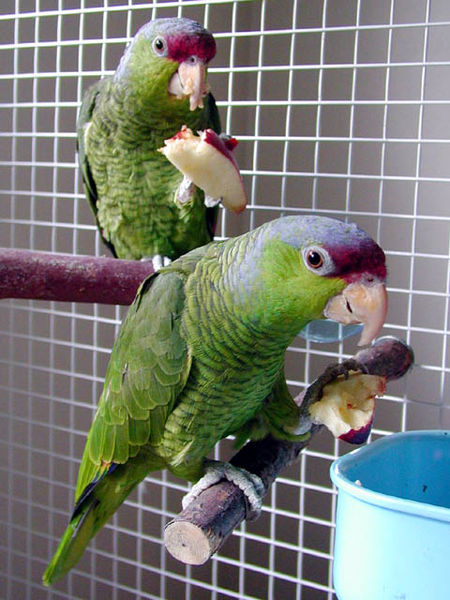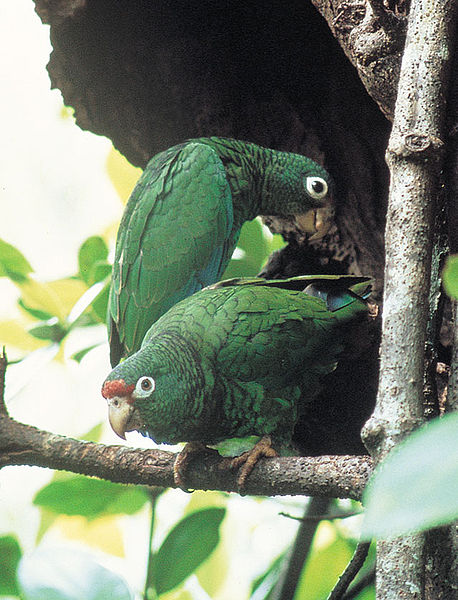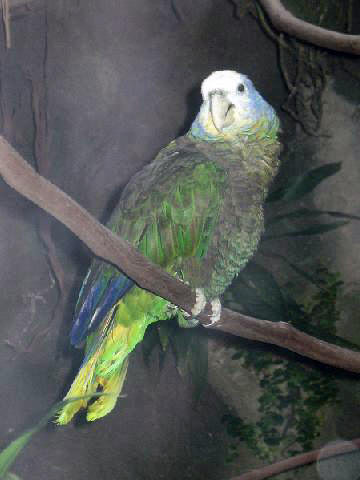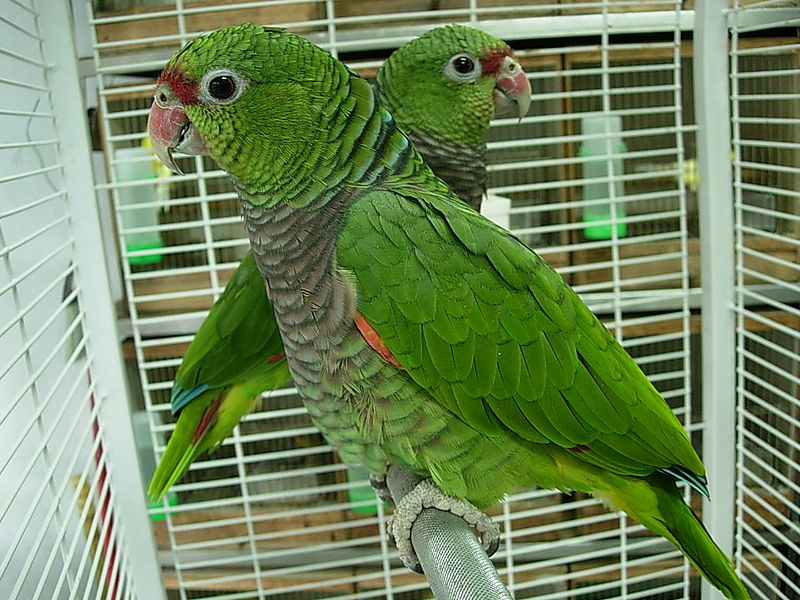The 27-30 parrots in the Genus Amazona, collectively known as “Amazons”, are among the world’s most popular avian pets. Indeed, they represent, at least to the general (i.e. “non-bird keeping”) public, the “typical” parrot. But they are far from typical in any manner, and the various species, while sharing some characteristics, differ greatly from one another.
I’d like to devote a good deal of time to this important and popular group, with an emphasis on the general personality traits of the various species. I’ll start here with those that are well-suited for beginners, and in future articles will cover larger Amazons, as well as some of the lesser-known and rare species. I’ll also include information on Amazons in the wild from time to time.
Range
Amazons of one kind of another range throughout much of Central and South America, and also occur on a number of Caribbean islands. The group includes quite common, rare and recently-extinct species.
General Characteristics
Amazons are feisty birds overall, much given to noisy bickering among themselves and nearly always on the go. They are quite hardy, with longevities exceeding 80 years for some species. They are considered by aviculturists to among the most intelligent and trainable of the parrots, and many individuals learn to speak well. Most bond strongly to their owners, and so make great companions.
Choosing a Species
Because the various Amazons are superficially similar – medium to large, mainly green, stoutly-built parrots with short, rounded tails, there is sometimes a tendency to lump them together, as regards their suitability as pets. However, as I hope to illustrate, care should be taken to match one’s personality with that of the parrot when choosing a pet. Of course, individual birds vary greatly within the same species, but there are some general species’ characteristics that can be helpful.
Surprisingly, the qualities mentioned in the preceding section render some Amazon species as poor choices for beginning parrot-keepers. Some are just too strong-willed and feisty, and need a great deal of room and attention. They quickly learn (almost always far sooner than their owners!) how to dominate their caretakers, and what they can get away with. These types, which I’ll cover in the future, are best left to experienced keepers.
Neophyte parrot fanciers do best with the smaller, quieter varieties that tend to have calm demeanors and a less “pushy” personality. I’ll start off with some examples of these.
Lilac-Crowned or Finsch’s Amazon, Amazona finschi
 Although well-known in captivity, this delightful parrot’s natural range is limited to foothills and mountainous terrain in western Mexico. The green feathers have a dark tint to their edges, lending the bird a quite unique appearance, and there is an attractive purple cast to the head. One of the smaller Amazons, it tops out at about 12 inches in length.
Although well-known in captivity, this delightful parrot’s natural range is limited to foothills and mountainous terrain in western Mexico. The green feathers have a dark tint to their edges, lending the bird a quite unique appearance, and there is an attractive purple cast to the head. One of the smaller Amazons, it tops out at about 12 inches in length.
Lilac-crowned Amazons are shyer than most of their relatives, and well-suited to a calm owner and quiet household. They are good talkers, and, if handled gently, make fine pets.
Blue-Fronted Amazon, Amazona aestiva aestiva
 The large range of this parrot extends from northeastern Brazil to Paraguay and northern Argentina. It seems, fortunately, to be a bit more resilient than other parrots as regards habitat loss, and is still to be found in good numbers in many areas.
The large range of this parrot extends from northeastern Brazil to Paraguay and northern Argentina. It seems, fortunately, to be a bit more resilient than other parrots as regards habitat loss, and is still to be found in good numbers in many areas.
Slightly larger than the lilac-crowned Amazon, the blue-fronted is also a good deal more vigorous and definitely a bit more of a challenge, That being said, it is an easily managed bird in the right hands, and is regarded as an excellent talker. They are quite energetic, and need to kept busy if they are to do well.
Blue-fronted Amazons have always been popular in Europe, but lag behind other Amazons here in the USA. Green in color and topped with a blue and yellow head, their unusually large eyes lend them a sensitive, “knowing” demeanor.
You can read about the natural history and conservation needs of the lilac-crowned Amazon at:
http://www.birdlife.org/datazone/species/index.html?action=SpcHTMDetails.asp&sid=1670&m=0
Lilac Crowned Amazon Photo referenced from Wikipedia, originally published by Ruth Rogers, and shared under Creative Commons Share 2.0
Blue-fronted Amazon picture referenced from Wikipedia, originally published by Snowmanradio, and shared under Creative Commons Share 2.0
 New efforts are underway to help 2 critically endangered Caribbean parrots, the Bahaman Amazon (Amazona leucocephala bahamensis) and the Puerto Rican Amazon (A. vittata). The various Caribbean islands are a hot-bed both of parrot diversity and parrot troubles – the Guadeloupe and Martinique Amazon Parrots, and a subspecies of the Puerto Rican Amazon (formerly found on Culebra Island), are already extinct.
New efforts are underway to help 2 critically endangered Caribbean parrots, the Bahaman Amazon (Amazona leucocephala bahamensis) and the Puerto Rican Amazon (A. vittata). The various Caribbean islands are a hot-bed both of parrot diversity and parrot troubles – the Guadeloupe and Martinique Amazon Parrots, and a subspecies of the Puerto Rican Amazon (formerly found on Culebra Island), are already extinct. That Bird Blog – Bird Care and History for Pet Birds
That Bird Blog – Bird Care and History for Pet Birds

 With only 30-35 individuals remaining in Puerto Rico’s Loquillo Mountains, this is quite likely the Neotropic’s rarest parrot. A related subspecies on nearby Culebra Island became extinct in 1912. The captive population of approximately 100 birds (which suffered serious losses due to thievery in 2001) is managed by the US Fish and Wildlife Service.
With only 30-35 individuals remaining in Puerto Rico’s Loquillo Mountains, this is quite likely the Neotropic’s rarest parrot. A related subspecies on nearby Culebra Island became extinct in 1912. The captive population of approximately 100 birds (which suffered serious losses due to thievery in 2001) is managed by the US Fish and Wildlife Service. I was very fortunate to have observed this colorful and rare bird while working with leatherback sea turtles on its tiny island home. I had not really expected to see it at the time, and the intervening 20 years have not dulled the very pleasant memory.
I was very fortunate to have observed this colorful and rare bird while working with leatherback sea turtles on its tiny island home. I had not really expected to see it at the time, and the intervening 20 years have not dulled the very pleasant memory. Another oddly marked (for an Amazon parrot) Caribbean island denizen, this parrot’s plumage contains a good deal of black, blue and violet, offset by orange, red and white about the head.
Another oddly marked (for an Amazon parrot) Caribbean island denizen, this parrot’s plumage contains a good deal of black, blue and violet, offset by orange, red and white about the head. The word “bright” comes to mind the first time one views this bird’s brilliant blue, green and red plumage…usually that view is of a photo, unfortunately, as the bird itself is exceedingly rare. All but 2 of the specimens known to be in the USA are housed at Florida’s Rare Species Conservancy.
The word “bright” comes to mind the first time one views this bird’s brilliant blue, green and red plumage…usually that view is of a photo, unfortunately, as the bird itself is exceedingly rare. All but 2 of the specimens known to be in the USA are housed at Florida’s Rare Species Conservancy. Yellow-napes are considered by many to be the ultimate parrot pet, and certainly their reputation for great intelligence is well-deserved. Large (to 16 inches), boisterous, vocal and active, the yellow-nape is best acquired as a hand-raised youngster. Birds that are not well-socialized when young are a real handful, and best left to very experienced (and patient!) aviculturists. Yellow napes do tend to use their powerful beaks to “make a point”, a further reason why well-tamed individuals are recommended.
Yellow-napes are considered by many to be the ultimate parrot pet, and certainly their reputation for great intelligence is well-deserved. Large (to 16 inches), boisterous, vocal and active, the yellow-nape is best acquired as a hand-raised youngster. Birds that are not well-socialized when young are a real handful, and best left to very experienced (and patient!) aviculturists. Yellow napes do tend to use their powerful beaks to “make a point”, a further reason why well-tamed individuals are recommended. The vinaceous Amazon differs from its relatives in general personality traits, being rather shy and retiring. Most have none of the “swagger” associated with its raucous cousins, and make gentle, affectionate pets. They fare best in quiet surroundings, and should be approached slowly, even when well-habituated to captivity.
The vinaceous Amazon differs from its relatives in general personality traits, being rather shy and retiring. Most have none of the “swagger” associated with its raucous cousins, and make gentle, affectionate pets. They fare best in quiet surroundings, and should be approached slowly, even when well-habituated to captivity. Although well-known in captivity, this delightful parrot’s natural range is limited to foothills and mountainous terrain in western Mexico. The green feathers have a dark tint to their edges, lending the bird a quite unique appearance, and there is an attractive purple cast to the head. One of the smaller Amazons, it tops out at about 12 inches in length.
Although well-known in captivity, this delightful parrot’s natural range is limited to foothills and mountainous terrain in western Mexico. The green feathers have a dark tint to their edges, lending the bird a quite unique appearance, and there is an attractive purple cast to the head. One of the smaller Amazons, it tops out at about 12 inches in length. The large range of this parrot extends from northeastern Brazil to Paraguay and northern Argentina. It seems, fortunately, to be a bit more resilient than other parrots as regards habitat loss, and is still to be found in good numbers in many areas.
The large range of this parrot extends from northeastern Brazil to Paraguay and northern Argentina. It seems, fortunately, to be a bit more resilient than other parrots as regards habitat loss, and is still to be found in good numbers in many areas.